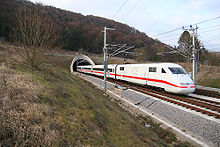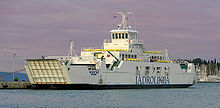Mode of transport
| Part of a series on |
| Transport |
|---|
| Modes |
| Topics |
|
|
A mode of transport is a method or way of traveling, or of transporting people or cargo.
In general,
Animal-powered
Animal-powered transport is the use of working animals for the transport of people and/or goods. Humans may use some of the animals directly, use them as pack animals for carrying goods, or harness them, alone or in teams, to pull watercraft, sleds, or wheeled vehicles.
Air
A
Air transport is the fastest method of transport, Commercial jets reach speeds of up to 955 kilometres per hour (593 mph) and a considerably higher ground speed if there is a
Human powered

Human powered transport, a form of
Although humans are able to walk without infrastructure, the transport can be enhanced through the use of roads, especially when using the human power with vehicles, such as
Land
Land transport covers all land-based transportation systems that provide for the movement of people, goods and services. Land transport plays a vital role in linking communities to each other. Land transport is a key factor in urban planning. It consists of 2 kinds, rail and road.
Rail

Road


A road is an identifiable route of travel, usually surfaced with gravel, asphalt or concrete, and supporting land passage by foot or by a number of vehicles.
The most common road vehicle in the developed world is the
Automobiles offer high flexibility, but are deemed with high energy and area use, and the main source of noise and air pollution in cities; buses allow for more efficient travel at the cost of reduced flexibility.[14] Road transport by truck is often the initial and final stage of freight transport.
Water

Water transport is the process of transport that a watercraft, such as a bart, ship or sailboat, makes over a body of water, such as a sea, ocean, lake, canal, or river. If a boat or other vessel can successfully pass through a waterway it is known as a navigable waterway. The need for buoyancy unites watercraft, and makes the hull a dominant aspect of its construction, maintenance and appearance. When a boat is floating on the water the hull of the boat is pushing aside water where the hull now is, this is known as displacement.
In the 1800s, the first
Although slow, modern sea transport is a highly effective method of transporting large quantities of non-perishable goods. Commercial vessels, nearly 35,000 in number, carried 7.4 billion tons of cargo in 2007.
Other modes
Micromobility is the collective name for small electric powered vehicles.
Cable transport is a broad mode where vehicles are pulled by cables instead of an internal power source. It is most commonly used at steep gradient. Typical solutions include aerial tramway, elevators, escalator and ski lifts; some of these are also categorized as conveyor transport.
Space transport is transport out of Earth's atmosphere into outer space by means of a spacecraft. While large amounts of research have gone into technology, it is rarely used except to put satellites into orbit, and conduct scientific experiments. However, people have landed on the moon, and probes have been sent to all the planets of the Solar System.
Components of a mode of transport
A transport mode is a combination of the following:
- bus terminals, airport terminals), etc.
- A stationary or mobile workforce
- Propulsion system and power supply (traction)
- Operations: driving, management, traffic signals, railway signalling, air traffic control, etc.
Comparison of the transport mode by distance travelled
This section needs to be updated. (November 2020) |
Worldwide, the most widely used modes for passenger transport are the Automobile (16,000 bn passenger km), followed by Buses (7,000), Air (2,800), Railways (1,900), and Urban Rail (250).[20]
The most widely used modes for freight transport are Sea (40,000 bn ton km), followed by Road (7,000), Railways (6,500), Oil pipelines (2,000) and Inland Navigation (1,500).[20]
| EU 15 [clarification needed] |
US | Japan | World | |
|---|---|---|---|---|
| GDP (PPP) per capita (€) (for comparison) |
19,000 | 28,600 | 26,000 | 7,500 |
| Private car | 10,100 | 33,200 | 6,200 | 2,700 |
| Bus/coach | 1,050 | 150 | 740 | 1,200 |
| Railway | 750 | 78 | 2,900 | 32 |
| Air (domestic except World) | 860 | 2,800 | 580 | 480 |
See also
References
- ^ "mode of transport". Collins Dictionary. Retrieved 14 July 2023.
- ^ Cooper et al., 1998: 281
- ^ a b Swine flu prompts EU warning on travel to the US. The Guardian. April 28, 2009.
- ^ The Future of Air Transport White Paper (2009), HMSO "The aviation industry is encouraged to take account of, and where appropriate reduce, its contribution to global warming...The impact of aviation on climate change is increased over that of direct CO2 emissions alone by some of the other emissions released and their specific effects at altitude".
- ^ IPCC, Aviation and the Global Atmosphere: A Special Report of the Intergovernmental Panel on Climate Change (2000), Cambridge University Press
- ^ Why airfare keeps rising despite lower oil prices Archived 2014-11-20 at the Wayback Machine, by Scott Mayerowitz, Assoc. Press Airlines Writer. Houston Chron., November 17, 2014.
- .
- S2CID 154791383.
- S2CID 8242255.
- ^ Jenkins S. (2009). Hypermobility is now the opium of the people, an obsession that wrecks communities and planet. The Guardian. 22 Dec. 2009.
- ^ Rosenthal E. (2010). Can we kick our addiction to flying? Guardian, UK. 24 May 2010.
- ^ Internet search for travel addiction.
- ^ Cooper et al., 1998: 279
- ^ Cooper et al., 1998: 278
- ^ United Nations Conference on Trade and Development 2007, p. x and p. 32.
- ^ Stopford, 1997: 4–6
- ^ Stopford, 1997: 8–9
- ^ Cooper et al., 1998: 280
- ^ "Zipline - Lifesaving Deliveries by Drone". flyzipline.com. Retrieved 2019-04-11.
- ^ a b c "Archived copy" (PDF). Archived from the original (PDF) on 2010-10-11. Retrieved 2006-05-26.
{{cite web}}: CS1 maint: archived copy as title (link)
